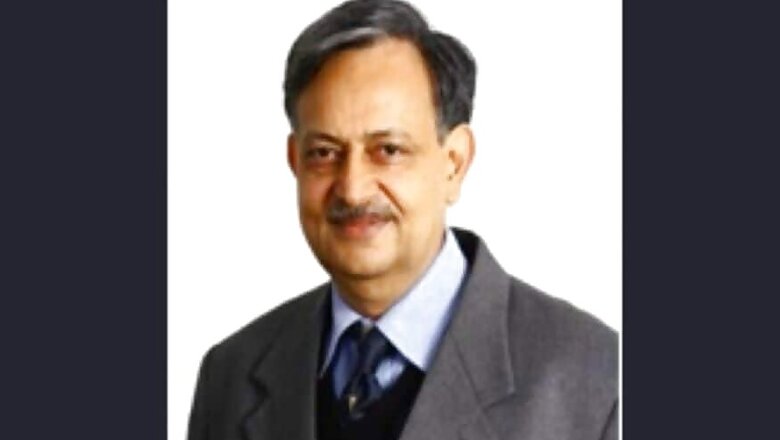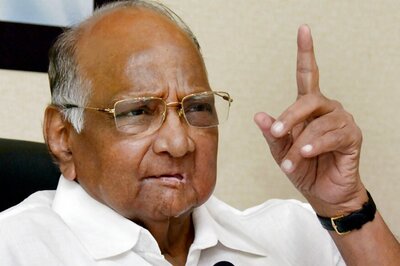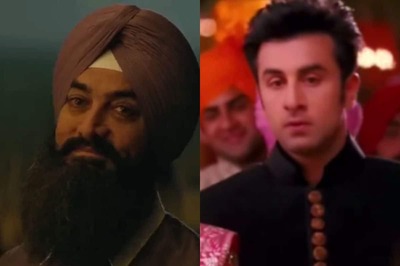
views
New Delhi: The number of coronavirus cases continues to soar in India with the total tally reaching 1,251 on Monday with 32 deaths. Alarming reports also emerged from the national capital where the Markaz Nizamuddin— Delhi headquarters of the Tablighi Jamaat — was sealed on Tuesday morning after a religious event in south Delhi’s Nizamuddin was linked to seven coronavirus deaths. A total of 200 people from the area with symptoms linked to COVID-19 are being tested.
In an interview to CNN-News18 Dr SK Sarin, who heads the task force formed by the Delhi government to prepare a blueprint in case the capital city does reach stage 3 of the virus, addresses the growing concerns of community transmission, Delhi’s preparedness for it and the availability of testing kits and protective gear.
There is a lot of speculation and panic about what has happened in the Nizamuddin area. According to reports, about 2,000 people have been quarantined and the entire area has been cordoned off. Would you classify what happened in Nizamuddin as a community transmission and, if not, why so?
The job given by Chief Minister Arvind Kejriwal and health minister was to give a report on the preparedness. I am not fully aware of what has happened at Nizamuddin, but if they have quarantined 2,000 people, it’s a good job because you are trying not to allow a spread. But let’s say the six people had it. One person probably had the infection and may be a close contact … five to six people would have the infection. So, this is generally considered as a person-to-person transmission. Say, I am Covid-19 positive and you are close by to me — say within six feet — then I can transmit the virus to you. If I am a patient and I have it, people surrounding me are at a high risk, doctors treating them are at a high risk and nurses and technicians treating them are all at a high risk. This is person-to-person transmission.
But if you find that ( community spread as you asked me ), you do not know the source and people are coming to the hospital with no known travel history, no known exposure, not being in touch with anyone or having treated any patient, and then they come then, I think, it is a community spread.
So these 2,000 people still are the contacts but in the community, all Indians must be ethical and wear a mask. It is more important for the patient and their contacts to wear a mask. But everyone does not have to wear a mask … the whole Delhi is moving around wearing a mask … that perhaps is not the best way. The mask will be required if you are in touch with somebody. This probably does not mean that we have a community spread, we cordoned off the area. Now the samples must be tested and a majority of them might come out negative.
The outbreak has triggered a lot of worry. A mohalla clinic doctor tested positive, his wife tested positive and a lot of patients who went to him for treatment have been quarantined. There is a lack of understanding as to why, when so many people are being quarantined (as in the second case), it is not called a community transmission. What would you say about that?
Whatever you may call it, I agree with you that people are scared, they feel stigmatised and marginalised. If you tell people, ‘my friend had Covid-19’, they will shun you off. They will not even look at you, they will write you off. This is not the way a society should behave. In fact, you should volunteer, saying, ‘I was in touch a person who has tested positive so please test me as well.’ If you are declared negative, feel happy that you can live happily in your family.
Korea had reached a stage where even at the bus stops, police stations and crossings, people were getting their nasal thing done (for Covid-19 testing). People don’t know how to take it and that is very important for learning. Just take a good nasal swab and just send it to the virus transport medium.
Or, a simpler way could be that people don't have to go to hospitals. They can go to some place where somebody who is trained can take nasal swabs. So they do not have that fear of being in a hospital. So, I think, one way could be that people could get tested and stay ‘negative’ to prevent community spread. Right now, we don't have enough evidence of it, but it can happen any day.
Are saying that a community spread can come any day?
Yes, that is true. This is what we had written in our possible scenarios that we gave to the Delhi government when they had mandated us to do this. We worked on scenarios that were based on the pivotal study published by New England Journal of Medicine about 1,099 patients in Wuhan. If you have 1,000 patients, of these 140 or 14 per cent would be sick enough to require hospitalisation. The good part of it, that is 86 per cent, do not require hospitalisation. So why is everybody scared? I don't know. They should think that ‘let me get tested and even if I test positive, it does not mean mujhe hospital mein rakha jayega…15 din rakha jayega(that I will have to be hospitalised for 15 days.)
Does this mean that even if you test positive for coronavirus, you may not require hospitalisation?
If you have cough and cold but don't have fever (then you do not). If you have high fever, dry cough and breathing problems, and influenza-like problems where the lungs are involved, only then you require hospitalisation. In fact, 80 to 85 per cent of patients — whether they are in the US or China — do not require hospitalisation. So, feel comfortable.
So a Covid-19 patient may not require hospitalisation. But we may still reach stage 3 of the pandemic. How prepared are we for it?
If 100 people test positive and 14 of them require hospitalisatiod due to, say, severe chest infection or diahhorea, then five may also require intensive care. Only five out of 100 would require it. That is not a big number. All patients of heart attack and accident victims … almost all such people need to be kept in the ICU. In case of coronavirus, five out of 100 positive cases would need an ICU and 2.3 per cent would require ventilator support. And we may lose about 1.4 per cent of people.
In every 1,000 patients, 14 mày die. The reality is not as grave as probably people have perceived it to be. You know, this is a perception fear more than reality.
But yes, for preparedness, we should be ready. So if Delhi gets 100 patients, these are the numbers. If we get 1,000 patients, which is our scenario three, then 140 patients would require hospitalisation and need ventilators. We prepared our report based on our understanding and available data and because of it two large hospitals — Lok Nayak Jai Prakash Narayan Hospital (LNJP) and Rajiv Gandhi Super Speciality Hospital (RGSSH) — are ready even now with 50 ICU beds and ventilators. Both can also have up to 100 isolation beds or so. The LNJP can accommodate up to 1,000 isolation cases and 100 ventillators, and the RGSSH can accommodate up to 200 isolation cases or even more. Many other hospitals are equipped with the same. But you also have to see that 80 per cent of the healthcare comes from the private sector and private hospitals have also volunteered. So, I think, Delhi is reasonably assessed to be prepared.
One important aspect is: how do you test a covid-19 suspect? People did not have testing kits till a few days ago. The testing kits started being available from this week. India is producing them and we are also getting them imported. So the rule is, test, test and test. Don't be scared. Volunteer to get tested. So if you are ‘negative’, you relax.
We said in our report that Delhi should have the capability to have 3,000 tests and have a reserve of several thousands. The Delhi cabinet has rapidly approved of it. They have ordered for the kits and will be available or are getting available from March 30. Many private labs also have to pitch in as always.
Where are the kits available? I have not seen them. In fact, a lot of people want to be tested for the infection but do not have the option of it.
So there were three scenarios: All samples were first being tested at the National Institute of Virology in Pune. Then the Indian Council of Medical Research (ICMR) started providing the primers — positive and negative controls — and we were also designated as a lab. So we now have the ICMR primer we can test with, the kits have come and three to four companies are regularly supplying. These kits are available at Institute of Liver and Biliary Sciences (ILBS) and Lady Hardinge Medical College... these are faster tests.
We are testing centres, not sample collection centres. There are about 17 sample collection centres but people don’t go there. Sample collection centres collect samples, put them in a viral transport tube and send them for testing.
But I think kits are available. A total of 500 kits, which means 50,000 tests, have been ordered by the Delhi government but everyone wants to have these kits. So the demand is more. But they are available in plenty.
Internationally, doctors wear several layers of protective gear while treating Covid-19 positive patients. What is the scenario in India? Why are the doctors unhappy? Why is that we frequently hear complaints that they are not adequately protected?
Well, I must ask you a question first and I will answer. Your first question to me was, 'Are you treating Covid-19 patients? Journalists are aware and they are asking these questions because they want to protect themselves and they are aware of the fact that if the doctor is Covid-19 positive, they should not get exposed to the infection. That is why when you came (for this interview) you were wearing a mask and I said, ‘no need to wear it because I am not treating any Covid-19 patient and do not have any symptoms’.
If the distance is more than six (meters) then doctors and healthcare workers are protected. But if the distance is less than six, they need protective gear. The Personal Protective Equipment (PPE) are in short supply everywhere but I think the Delhi government has ordered for thousands. In places where samples are being collected or in places like Institute of Liver and Biliary Sciences (ILBS), where we are testing suspects, enough number of PPE kits are available. In Lok Nayak Jai Prakash Narayan Hospital and Rajiv Gandhi Super Speciality Hospital, too, these kits are available. The other thing you require is the N95 mask. These are also available in plenty. Suppose you don't have the N95 masks, you can put two surgical masks and see that the air does not come out or get in. What we need to do is protect the mucous membrane. One is eyes, one is nose, one is mouth. Cover them well. You can also use a simple plastic sheet and tie them well. Impervious gowns shields are also required and I think they are in plenty. The Government of Delhi is working overtime. The minister of health is monitoring the situation every two hours.
The committee that we have is serving as a model. We are also learning every day . Other states can use that. This model can be replicated. I want to tell people that they should not be scared, they must come out to get tested as the kits are available. ‘Quarantining 2,000 From Nizamuddin Good Move’: Delhi Doctor Leading Covid-19 Battle Says No Community Spread Yet



















Comments
0 comment